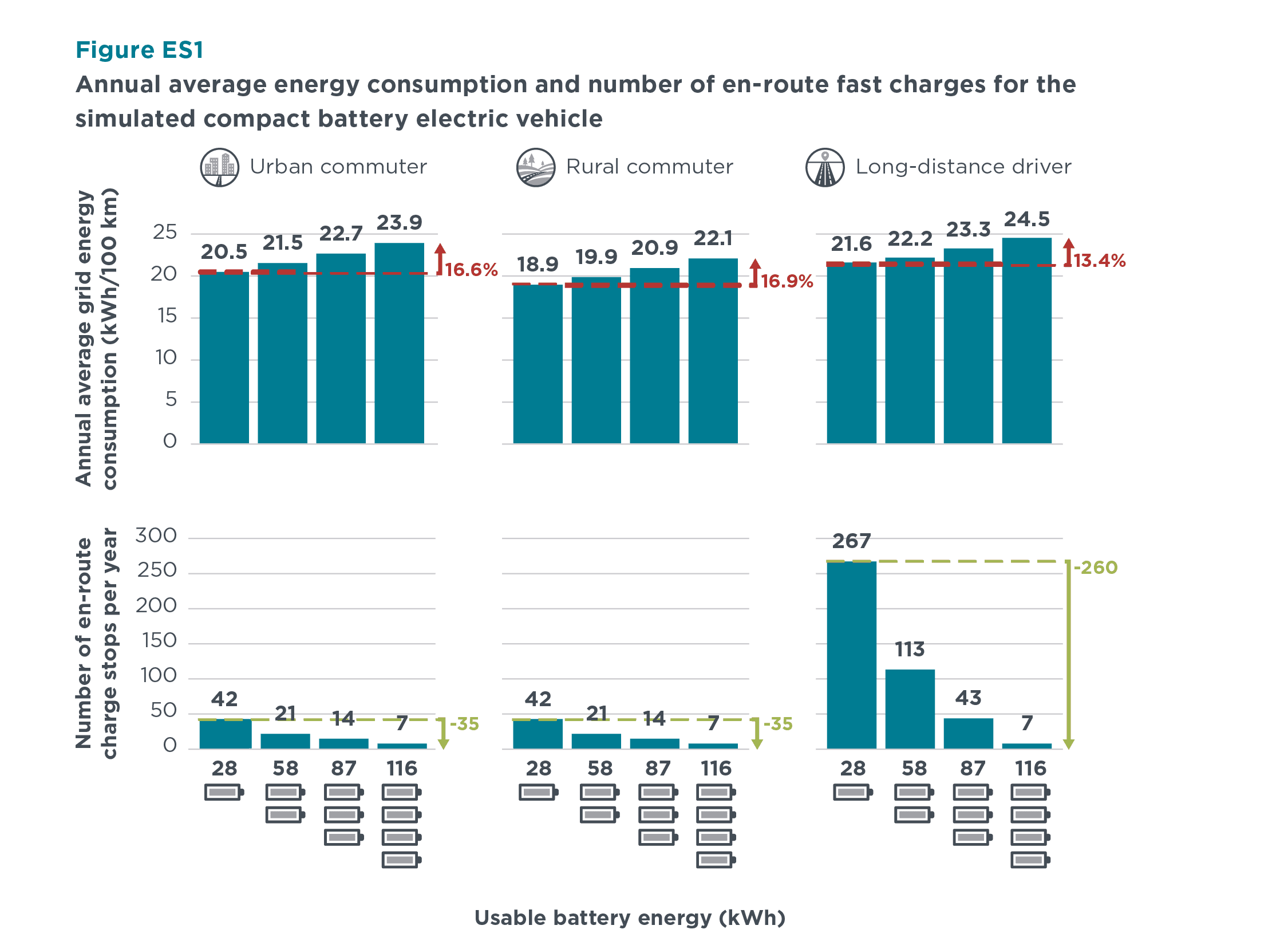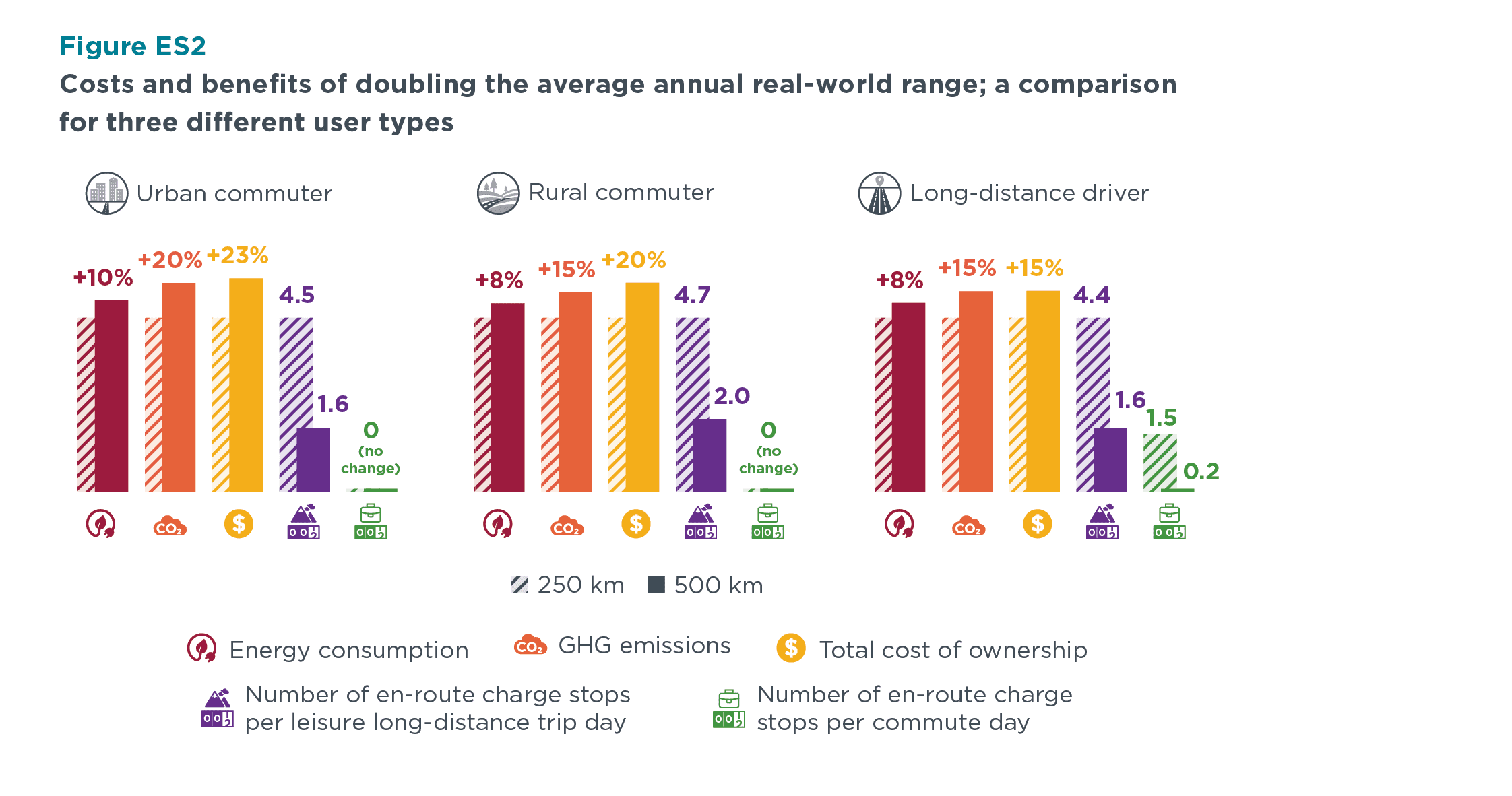Report
The bigger the better? How battery size affects real-world energy consumption, cost of ownership, and life- cycle emissions of electric vehicles
Range anxiety, or a driver’s fear of not reaching their destination or the next charging station on a single battery charge, is often cited as a primary concern for potential buyers and users of battery electric cars. In Europe, the median driving range of battery-powered passenger cars was 419 km in 2022, reflecting a 10% increase over two years. Nearly 60% of Europeans have expressed that a driving range of 500 km is the minimum they would consider for purchasing a battery electric vehicle (BEV).
Because longer ranges require larger capacity batteries, concerns are growing over the environmental and economic tradeoff between larger batteries and the actual benefits for drivers. While longer ranges promise autonomy and convenience for the driver, the associated larger battery increases energy consumption and greenhouse gas emissions over a vehicle’s lifetime. Furthermore, it increases the overall vehicle’s costs due to higher purchase price and operational expenses.
An alternative to a larger battery is opting for a smaller one and using fast charging during longer-distance trips. However, fast charging also comes with some disadvantages. Fast charging is more expensive than slow charging and requires more energy for battery temperature control.
This study simulates driving profiles for three generic user types over the course of one year: an urban commuter, a rural commuter, and a frequent long-distance driver. The users are assumed to have access to charging when needed or when convenient.
Simulation: Urban, rural, and long-distance drivers
A compact battery electric vehicle was modeled, resembling the Volkswagen ID.3, and the effect of battery size was analyzed by simulating four battery capacities: 28, 58, 87, and 116 kWh. The analysis takes into account the effect of the battery capacity on vehicle mass, the type of charging used, and the energy consumption of the thermal management system for the cabin and battery. It also considers the annual ambient temperature variability of Berlin, Germany.
Key findings
The simulation results provide insights for consumers and regulators, with the key findings described below and summarized in Figures 1 and 2.
A larger battery size increases the energy consumption for all users, but only the long-distance driver benefits from a substantial decrease in en-route charging stops. Using a 116-kWh battery instead of a 28-kWh battery increases energy consumption between 13.4% and 16.9% for the three driver types. For long-distance drivers, en-route charging stops per year decrease by 260. However, urban and rural commuters will only save 35 additional stops because the range of the smaller battery capacity covers most of their trips.
Doubling the battery electric vehicle range from 250 to 500 km will raise the total cost of ownership by 15% to 23%. The higher total cost of ownership is more pronounced for the rural and urban driver types, with 20% and 23% higher costs, respectively. The lower energy consumption and purchase price of a vehicle with a smaller battery result in substantially lower expenses despite the higher electricity cost associated with more frequent fast charging.
Using a small battery and reducing electric energy consumption contributes to lower vehicle life-cycle greenhouse gas emissions for all users. In relative terms, the urban commuter experiences the biggest increase in emissions when doubling the battery size (20%). This is due to the more frequent and shorter trips of this user type, which requires more frequent cooling or heating of the cabin and battery and thereby increases the energy consumption of the thermal management system.

Conclusions and policy recommendations
- Most of the year, a larger battery does not affect the number of en-route charging stops for the urban and rural driver types. Fast charging stops are only required during long-distance trips. In the case of urban and rural commuters, days with long-distance trips represent less than 2% of those taken in a year. Doubling the range from 250 to 500 km will not decrease the number of days where en-route charging is required but will reduce the number of charging stops per long-distance trip to two.
- The long-distance driver will benefit from a longer range with one charging stop less per commute day but at the expense of 15% higher costs. Due to the frequent long-distance trips, the long-distance driver benefits most from a vehicle with a 500-km range compared to a vehicle with a 250-km range. However, for the urban and rural commuter user types, the larger battery comes at a considerably higher cost than a smaller battery combined with fast charging.
- BEV energy consumption and range are strongly affected by ambient conditions and vehicle usage. Due to the energy consumption of the heating and air conditioning system, as well as of the battery thermal management system, the average energy consumption and the available range vary substantially from month to month. This effect is especially pronounced for users who frequently drive short-distance trips.
- Policymakers could consider collecting real-world energy consumption data from BEVs using on-board fuel and energy consumption monitoring devices. The simulated real-world energy consumption in this study is 29% to 44% higher than the type-approval value. For verifying the representativeness of BEV type-approval values, collecting reliable real-world energy consumption is essential. It is also a prerequisite for providing consumers with comprehensive information, determining life-cycle emissions, and assessing the impact of electric vehicle energy consumption limits. These analyses could be performed by the European Commission as defined in the CO2 standards for cars and vans.

About the methodology
In order to simulate a wide range of battery sizes for the same vehicle model, the study uses the Siemens Simcenter Amesim simulation software. The vehicle model data is obtained from a recent test project conducted by the Technical University of Munich (TUM) and from the German car club ADAC database. The thermal management system model is calibrated using findings of a study real-world electric vehicle energy consumption published by the German Federal Environment Agency. The vehicle mode is calibrated to match the official Worldwide harmonized Light vehicles Test Procedure (WLTP) energy consumption values of the reference Volkswagen ID.3 vehicle with a 58-kWh battery and to the consumer-reported values in spritmonitor.de.
For media and press inquiries, please contact Susana Irles, Senior Communications Specialist, at communications@theicct.org.
